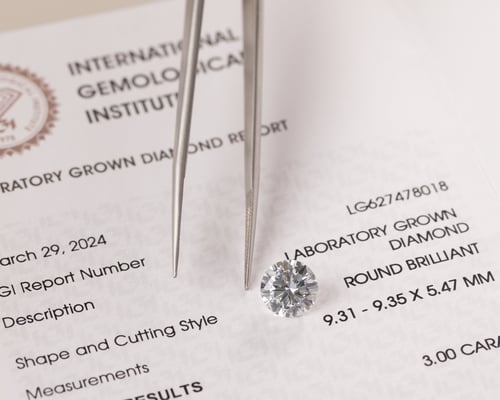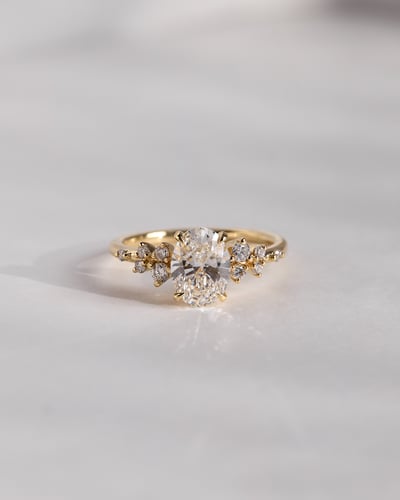.jpg)
— by Cullen Jewellery — Reading time 4 minutes
The Cullen Guide to Understanding Lab Grown Diamond Ratios
Beyond the 4 Cs lies a subtle detail that shapes everything – the length-to-width ratio of a lab grown diamond. It influences how a stone sits on the hand, how the light moves through it, how large it appears at a glance, and its cost. Some ratios feel sculptural and elongated, others compact and bold. On a longer finger, a slender stone might emphasise its length. On a shorter finger, wider cuts tend to look more in proportion with the hand’s natural shape. There’s no ‘perfect’ ratio – only the one that feels right for you. Because at the end of the day, the most unique lab grown diamond is the one that reflects your style and story.
What’s a diamond ratio?

Contrary to what popular culture (and every romcom ever) would have you believe, it’s not always the weight of a diamond – also known as its carats – that’s the be-all and end-all of diamond decision-making. Yes, carat is one of the 4 Cs in the Gemological Institute of America’s (GIA) ‘4 Cs of Diamond Quality’ (alongside cut, colour and clarity). But carats don’t tell the whole story when it comes to a lab grown diamond – there’s also its ratio.
So, what’s a diamond ratio? In simple, somewhat mathematical, terms it’s a measurement that applies to elongated cuts (think Oval, Emerald, Pears, etc.) and is calculated by dividing the length of the stone by its width. Essentially, it informs how long or short the diamond appears. Typically, a lower ratio (closer to 1.0) results in a shorter, wider look, while a higher ratio (closer to 2.0) creates a more elongated, slim appearance. A diamond ratio helps reveal the balance and symmetry that make a stone stand out – and it’s a key part of crafting engagement rings that look harmoniously proportioned.
Why understanding a diamond’s ratio can help you find ‘the one’

Understanding a diamond’s ratio and how it influences overall appearance can elevate your engagement ring experience. It’ll give you a deeper appreciation for the ideal width-to-height proportions that make a lab grown diamond not just visually stunning but purposefully balanced – maximising light dispersion and enhancing its brilliance.
How does a diamond’s ratio impact how it appears?
A diamond’s ratio plays a big role in how it looks – affecting its simplicity, visual balance and even how large it appears. If the ratio is off, the diamond can seem disproportionate or dull. When choosing a lab grown diamond, it’s worth considering how the ratio complements the setting, the wearer’s style and also the shape of their hand (a more elongated stone might match someone with long fingers, for example). The right proportions enhance symmetry and brilliance, allowing the diamond to reflect and disperse light more effectively. Even a small shift in ratio can subtly change its shape or how it catches the light.
Understanding length-to-width ratios across diamond shapes

When choosing a diamond, the length-to-width ratio is a key factor that determines the shape's overall look – whether it appears long or short. It’s especially important for elongated cuts, as it affects not only the diamond’s face-up appearance but also how its carat weight is distributed. A higher ratio (closer to 2.0) gives a more elongated look, which can visually lengthen the finger, while a lower ratio (closer to 1.0) creates a wider, more balanced shape.
Here’s a guide to the most popular ratio ranges by shape:
- Oval: 1.35 – 1.5
- Pear: 1.45 – 1.65
- Princess: 1.00 – 1.03
- Radiant: 1.35 – 1.5
- Emerald: 1.3 – 1.5
- Cushion (Classic): 1.00 – 1.03
- Elongated Cushion (Brilliant): 1.2 – 1.3
- Elongated Cushion (Modified Brilliant): 1.3 – 1.45
- Heart: 1.00 – 1.03
- Marquise: 1.85 – 2.1
- Asscher: 1.00 – 1.03
- Elongated Hexagon: 1.6 – 2.0
The Cullen Difference when it comes to lab grown diamond ratios

We’re proud to offer a large collection of stone shapes, each available in a wide range of ratios – making it easy to find the diamond that suits you best. With meticulous craftsmanship and an eye for detail, we ensure every engagement ring is perfectly proportioned and catches the light just right. When browsing our lab grown diamonds online, you can filter by ratio to focus on the most sought-after proportions. It’s also worth considering how the stone will be set – elongated shapes tend to shine in solitaire settings, while wider or squarer cuts often suit trilogies and halos.
It’s a personal choice

A lab grown diamond’s length-to-width ratio is ultimately a matter of individual taste. At Cullen Jewellery, we’re here to guide and educate on your journey by sharing the ‘classic’ ratios mentioned in this piece. However, at the end of the day, it all comes down to what you love.
Need more assistance with understanding lab grown diamond ratios? We’re here to help. Book a virtual appointment today.



